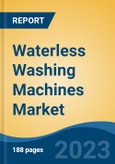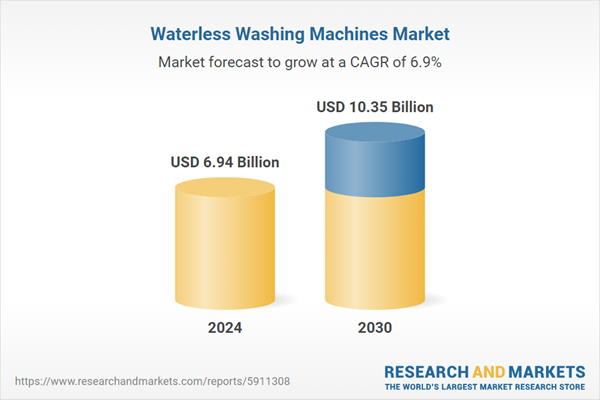Speak directly to the analyst to clarify any post sales queries you may have.
10% Free customizationThis report comes with 10% free customization, enabling you to add data that meets your specific business needs.
Key Market Drivers
Environmental Sustainability and Water Scarcity Concerns
Water scarcity is a pressing global issue, with nearly 2.3 billion people living in water-stressed regions. Traditional washing machines are among the largest household water consumers, accounting for approximately 12-15% of global freshwater withdrawals. Waterless washing machines offer a sustainable solution by reducing water usage by up to 90% compared to conventional models. This significant reduction in water consumption aligns with global efforts to conserve water resources and mitigate environmental impact. Countries like India, South Africa, and Australia, facing acute water shortages, are increasingly adopting waterless technologies to address these challenges.Key Market Challenges
High Initial Cost and Affordability Issues
One of the primary challenges hindering the widespread adoption of waterless washing machines is their high initial purchase cost. Unlike conventional washing machines, which benefit from mass production and mature manufacturing processes, waterless models rely on advanced technologies such as ultrasonic cleaning, polymer beads, and air-based systems. These cutting-edge mechanisms require specialized components and research-driven engineering, which increase the production cost significantly. As a result, waterless washing machines are often priced 30-50% higher than traditional models, making them less accessible to middle- and lower-income households, particularly in developing countries.Consumers may hesitate to invest in these machines due to the perception that the high upfront cost may not justify the long-term benefits, even though they offer water and energy savings. Additionally, the lack of financing options or installment-based schemes in many regions further limits affordability. The high price point also impacts large-scale adoption in institutional or commercial settings, where upfront capital expenditures are closely scrutinized. Consequently, manufacturers face a significant barrier in expanding their market reach, requiring strategies to reduce costs through economies of scale, modular designs, or strategic partnerships to make these appliances more affordable to a wider audience.
Key Market Trends
Integration of Smart and IoT Technologies
A prominent trend in the waterless washing machine market is the increasing integration of smart and Internet of Things (IoT) technologies. Modern waterless machines are being equipped with Wi-Fi connectivity, smartphone apps, and AI-enabled sensors that optimize cleaning cycles, monitor energy usage, and alert users when maintenance is required. For instance, some models can detect fabric type, load size, and soil level to automatically adjust the ultrasonic cleaning intensity or air-based mechanisms for optimal results. This trend not only enhances user convenience but also positions waterless machines as high-tech appliances compatible with smart homes.Consumers increasingly value connected devices that simplify laundry routines, provide remote control, and enable data-driven efficiency improvements. As smart home ecosystems expand, manufacturers are focusing on seamless integration with voice assistants like Amazon Alexa and Google Assistant, allowing users to start, pause, or monitor cleaning cycles with simple voice commands. The adoption of smart technology in waterless washing machines is expected to drive market differentiation and appeal to tech-savvy, urban consumers who prioritize both sustainability and convenience.
Key Market Players
- Xeros Technology
- 80 Wash
- LG Electronics
- Whirlpool Corporation
- IFB Home Appliances
- Samsung Electronics
- Hisense
- Haier
- BSH Home Appliances
- Electrolux
Report Scope:
In this report, the Global Waterless Washing Machines Market has been segmented into the following categories, in addition to the industry trends which have also been detailed below:Waterless Washing Machines Market, By Technology:
- Ultrasonic Cleaning System
- Polymer Based Washing System
- Carbon Dioxide Washing
Waterless Washing Machines Market, By End User:
- Residential
- Commercial
Waterless Washing Machines Market, By Distribution Channel:
- Online
- Offline
Waterless Washing Machines Market, By Region:
- North America
- United States
- Canada
- Mexico
- Europe
- France
- United Kingdom
- Italy
- Germany
- Spain
- Asia-Pacific
- China
- Japan
- India
- South Korea
- Vietnam
- South America
- Argentina
- Colombia
- Brazil
- Middle East & Africa
- South Africa
- Saudi Arabia
- UAE
- Turkey
Competitive Landscape
Company Profiles: Detailed analysis of the major companies present in the Global Waterless Washing Machines Market.Available Customizations:
With the given market data, the publisher offers customizations according to a company's specific needs. The following customization options are available for the report.Company Information
- Detailed analysis and profiling of additional market players (up to five).
This product will be delivered within 1-3 business days.
Table of Contents
Companies Mentioned
- Xeros Technology
- 80 Wash
- LG Electronics
- Whirlpool Corporation
- IFB Home Appliances
- Samsung Electronics
- Hisense
- Haier
- BSH Home Appliances
- Electrolux
Table Information
| Report Attribute | Details |
|---|---|
| No. of Pages | 180 |
| Published | September 2025 |
| Forecast Period | 2024 - 2030 |
| Estimated Market Value ( USD | $ 6.94 Billion |
| Forecasted Market Value ( USD | $ 10.35 Billion |
| Compound Annual Growth Rate | 6.8% |
| Regions Covered | Global |
| No. of Companies Mentioned | 10 |









